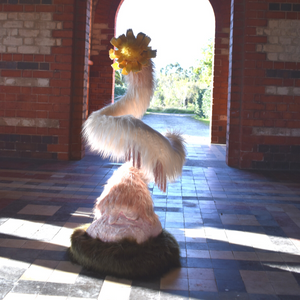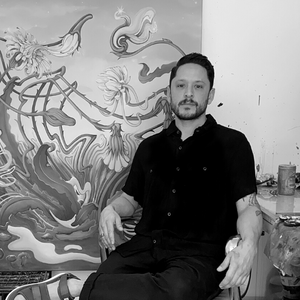Opening Ceremony (2022)
Wood, plywood, plaster, polymer, polyurethane, fabric, acrylic paint, resin, epoxy, aluminium, steel and faux fur

In Opening Ceremony, I recall the grasslands and fields of the remote rural property that I lived on in Walbunja Country, NSW for the past five years. During the La Nina weather cycle, these fields and understories erupted with an abundance of native flowers, fungi and introduced exotics, forming entangled matts of texture and colour. One flower was decidedly ubiquitous however – the introduced yellow Dandelion. During this time, I became fixated with its unrelenting spread, a persistent reminder of the Anthropocene and the environmental imbalances that it has heralded. Conversely, I was entranced by its beauty and subtle behaviours; petals closing up nightly and slowly reopening each morning to greet the sun, a daily ritual or ceremony serving as a poetic reminder of the interconnectedness of life
About the Artist
 Eduardo Wolfe-Alegria lives on Ngunnawal and Walbunja Country, in the NSW Southern Tablelands. He has a Master of Fine Art, from Sydney College of the Arts and has exhibited at Airspace Projects, Hazelhurst Regional Gallery, Gaffa Gallery and The Bearded Tit. He also teaches Illustration and drawing at UTS. Eduardo draws from tropes of fantasy and mythology to reinterpret his environment, creating imagery that is at once metamorphic, psychedelic and surreal. Laced with a distinctly queer sense of camp and humour his fantastical artworks seek to remind us of our connection to the natural world, with its seen and unseen forces.
Eduardo Wolfe-Alegria lives on Ngunnawal and Walbunja Country, in the NSW Southern Tablelands. He has a Master of Fine Art, from Sydney College of the Arts and has exhibited at Airspace Projects, Hazelhurst Regional Gallery, Gaffa Gallery and The Bearded Tit. He also teaches Illustration and drawing at UTS. Eduardo draws from tropes of fantasy and mythology to reinterpret his environment, creating imagery that is at once metamorphic, psychedelic and surreal. Laced with a distinctly queer sense of camp and humour his fantastical artworks seek to remind us of our connection to the natural world, with its seen and unseen forces.
Transcription
My name is Eduardo Wolfe-Alegria and the title of my work is “Opening Ceremony”.
“Opening Ceremony” is an installation which interprets the grasses and fields of Walbunja country or the Southern Tablelands where I lived for five years on a remote property, through a lens of anthropomorphism and surrealism.
This lens is the cornerstone of my practice. Most of my work involves interpreting my experiences, my observations and my memories through this lens of surrealism, anthropomorphism and even fantasy. This work looks at those fields on Walbunja country or the Southern Table Lens, through this surrealist Lens. In the lead up to this work, I started to pay a lot of attention to the grasses and the fields on the property.
After La Nina, the fields erupted with life and what I tended to see as being quite a brown landscape… suddenly became full of life and colour. I started observing this whole variety of life, some of them introduced species or exotics, as well as native species like Australian orchards and lilies, as well as lots of amazing fungi. But it was one species that I noticed starting to take over and that was the Yellow Dandelion. I started paying attention to the Dandelions and became a little bit obsessed with them, noticing how they opened and closed each day. This is something I hadn’t previously seen on mass, and it became like an amazing ritual that they would undertake - in the morning they would all be closed and then throughout the day I observed them opening up and then you'd have this field of amazing yellow and then it would close back up at the end of the day.
But it’s hard to ignore the negative aspect of it (this ritual), in that the dandelions are a weed. So, that became the other aspect of the work, this darkness, or an undercurrent where, the Dandelions, while they're beautiful, are also a symbol of colonization and the anthropocene….
In many ways I’d describe myself first as a painter and then a sculptor. So, most of my sculptural ideas and projects come out of my painting and drawing practice. So, this particular work, its initial birth, or the initial idea actually came from a large-scale painting that I created while I was still living on the property, which (depicted) big anthropomorphic and metamorphic dandelions.
In terms of starting the process of making my work, I tend to start with quite a loose sketch. I'm not a super meticulous planner, the process is quite organic for me. But that initial sketch will capture the general composition and essence of the idea. Then I'll get started on the works. The first thing is the structure, or the armature. The armature has been made from metal as well as some foam then it's building up layers onto that. So once that's dried, I work with plaster and fabric dipped into plaster and that's applied to the stand. Once that's sealed in with an acrylic sealer, then I'll start working on the intricate detailed bits.
Normally, I'll use polymer clays, and also modelling clays and then cast them using silicone. And sometimes some of the bits are a little bit hard to cast. I also have like another modelling compound which I'll finish some of the detail with and then it's hand painted and at the end I'll glue fabrics and different textual aspects on. So it's very time consuming and there's lots of layers….
In relation to the HIDDEN Exhibition, and more broadly its themes of death and rebirth, I focus on the life cycle of the dandelions, the flowers opening and closing every day and the poetry of that cycle. (I marvel at how it expresses), in this really basic, yet beautiful and poetic way, the interconnectedness of life, marvelling at the way that they open up each day to greet the sun and then that sets off another chain of events…. So, it’s these little details creating a kind of symphonic relationship in nature. Other concerns that tend to drive my work are questions about the life force or the force that animates things, what makes things move, what makes things think and feel, you know, and I think people often overlook plants and think of them as inanimate, or as a lower life form... I’m fascinated by plants and what it is that drives them and the way that they move, the way that they survive, the way that they interact with the things around them. But that's also a question which might lead us to consciousness, bringing us back to what some people might deem as spiritual…. or this idea of consciousness…. Bringing us back to life, death and the cemetery, and on a more literal level, looking at the grasses or the undergrowth of the cemetery.
There's definitely a lot going on and a lot of weeds and fungi and also introduced species. So, my work has that relationship as well. My hope is that the viewer might look at the little things around us afresh, things that are often overlooked, like the weeds or the grass that you might walk on, on the side of a road or popping up through a crack on the sidewalk, and seeing how wondrous, strange and even trippy those details around us can be. And on the flip side, to think about how much we have altered the environment around us and how ultimately frightening that is.